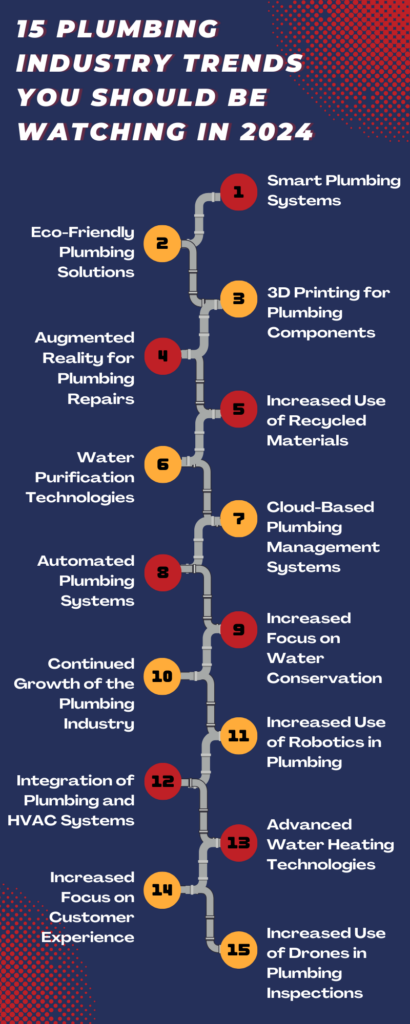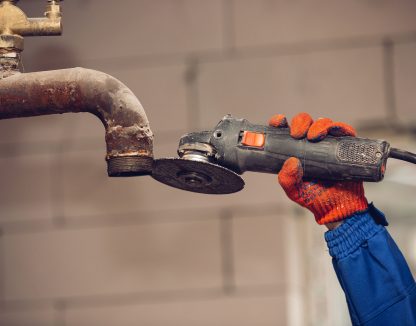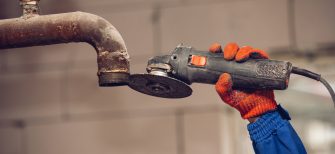Plumbing is an essential industry that is constantly evolving and adapting to new trends and technologies. As we enter 2024, there are several plumbing industry trends that you should be watching out for to stay up-to-date and keep your business current.
Ready to Learn More?
1. Smart Plumbing Systems
One of the most significant trends in the plumbing industry is the rise of smart plumbing systems. These smart technology systems utilize advanced sensors, IoT devices, and machine learning algorithms to provide real-time monitoring of plumbing systems. Smart plumbing systems can detect leaking pipes, monitor water consumption, and predict potential problems before causing issues like water damage and will become increasingly popular.
2. Eco-Friendly Plumbing Solutions

The growing focus on environmental sustainability has led to a demand for eco-friendly plumbing solutions. In 2023, we can expect to see more homes and businesses adopting eco-friendly plumbing technologies like low-flow toilets, water-saving faucets, and rainwater harvesting systems.
3. 3D Printing for Plumbing Components
The use of 3D printing in the plumbing industry is expected to increase in 2023. With 3D printing technology, plumbing fixtures can be manufactured quickly and easily, reducing the need for costly and time-consuming traditional manufacturing processes.
4. Augmented Reality for Plumbing Repairs
Augmented reality technology is increasingly being used for plumbing repairs. Plumbers can use AR devices to visualize plumbing systems and diagnose problems faster with higher accuracy.
AR is also becoming popular for hands-on training for plumbing technicians. Technicians can navigate a variety of real-world situations and complete training hours and practice new situations from their own office.
5. Increased Use of Recycled Materials
As the demand for eco-friendly plumbing solutions grows, so does the use of recycled materials in plumbing systems. Recycled materials can be used to make pipes, fixtures, and other plumbing components, reducing the industry’s environmental footprint.
6. Water Purification Technologies
Water purification technologies are becoming increasingly advanced, with new systems that can remove even more contaminants from water. In 2024, we can expect to see more homes and businesses adopting water purification technologies like reverse osmosis systems and UV water purification systems.
7. Cloud-Based Plumbing Management Systems
Cloud-based plumbing management systems provide real-time monitoring of plumbing systems, enabling homeowners and business owners to detect potential problems before they occur. These systems can also be used to track water usage and identify areas where water conservation can be improved.
8. Automated Plumbing Systems
Automated plumbing systems can help to reduce water waste and improve energy efficiency. These systems use sensors and other technologies to automatically adjust water usage and temperature, reducing the need for manual adjustments.
9. Increased Focus on Water Conservation
Water conservation is a growing concern in many areas of the world. In 2024, we can expect to see an increased focus on water conservation in the plumbing industry, with more homes and businesses adopting water-saving technologies.
10. Continued Growth of the Plumbing Industry
The plumbing industry is expected to continue to grow in 2024, driven by factors like population growth, urbanization, and an increased focus on environmental sustainability. The Bureau of Labor Statistics predicts that employment of plumbers, pipefitters, and steamfitters will grow 4 percent from 2019 to 2029, which is as fast as the average for all occupations. As the population continues to grow, and as more buildings are constructed and renovated, there will be an increasing demand for plumbing services.
11. Increased Use of Robotics in Plumbing
Robotic technologies are increasingly being used in the plumbing industry to automate tasks like pipe inspection, leak detection, and drain cleaning. Robotic tools can be remotely controlled and used in areas that are difficult or dangerous for humans to access. They can also improve the efficiency and accuracy of plumbing services.
Some plumbing companies have already begun using robots in their work. For example, some companies use robots for sewer inspection and cleaning, which can save time and reduce costs. Robotic cameras can also provide more accurate and detailed images of pipes, allowing plumbers to identify and address issues more effectively.
12. Integration of Plumbing and HVAC Systems
The integration of plumbing and HVAC systems is becoming more common, with systems that can provide heating, cooling, and hot water all in one package.
13. Advanced Water Heating Technologies
New water heating technologies are being developed that can provide hot water more efficiently and with less waste. These technologies include tankless water heaters, heat pump water heaters, and solar water heaters.
14. Increased Use of Drones in Plumbing Inspections
Drones are increasingly being used in plumbing inspections, enabling plumbers to access hard-to-reach areas like rooftops and gutters.
15. Increased Focus on Customer Experience
As the plumbing industry continues to evolve, an increasing focus on customer experience is expected to emerge in 2024. Plumbing companies are realizing that providing exceptional customer service is key to standing out in a competitive market.
One aspect of the increased focus on customer experience is the use of technology to improve communication between plumbers and customers. Plumbing companies may offer online scheduling, text message updates, and real-time tracking of plumbing jobs to keep customers informed throughout the process.
Plumbing companies may also invest in tools and technologies that can improve the customer experience, such as mobile payment options, on-site estimates, and follow-up surveys to gather feedback from customers.





